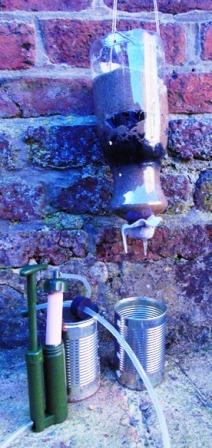Water is often muddy or too salty to drink. Sometimes it contains heavy metals or toxic substances. Or dangerous bacteria. There are options to disable or reduce some of these risks.
You can make water drinkable by filtering
 You press the water through an ultra-fine sieve that stops protozoa and bacteria. This can be cumbersome, with little yield, and the possible need for additional disinfection.
You press the water through an ultra-fine sieve that stops protozoa and bacteria. This can be cumbersome, with little yield, and the possible need for additional disinfection.
By adsorption by activated carbon (by superheated steam activated burned wood or coal) residues of pesticides, detergents and the like are removed. Smell and taste problems also will be solved this way.
You can create a filter with a tube (e.g. bottomless bottle or jar) or hanging layers of filter material separated by fabric or braid ranging from coarse to fine like ’hammocks’ above each other: gravel - sand –charcoal- sand - pebble. The first more turbid filtered water you better pour away. After filtering always still cook it.
A cascade is a waterfall between obstacles on different levels, a stairs waterfall. A cascade system is a process that changes in steps, and wherein the content flows to a lower level after reaching a certain limit or capacity. For water it is often used as a filter to precipitate particles. It can be applied also in overflowing of vessels, and in a septic tank.
Cheap, durable filter of seeds and sand
In 2014, researchers showed that milled seed (in a sand bed) of the drought tolerant Moringa oleifera tree from the Himalayas can clean water. The turbidity reduces by 80 to 99.5 percent and the number of bacteria by as much as 99 percent. The powder of the seeds provides water-soluble organic polymers (the protein: Moringa Oleifera Cationic Protein MOCP) that does clump together and precipitate most of the impurities and pathogenic particles from the water. To be drinkable the water must be boiled.
The tree also provides oil for cooking and lighting. The seed pods, seeds, leaves, roots and flowers are edible and rich in protein.
The residue is collected as a soil sludge.
Wooden water filter
With a piece of debarked branch (2.5 cm, fresh green wood) you can make an appropriate plug for a tube (or bottomless bottle). The porosity of the pores, vessels and membranes of the outer xylem (sapwood) allow transport of water and act as a micro filter. It may purify 4 liters of water per day, and according to Rohit Karnik of MIT stop bacteria (taller than 70 nanometers), including more than 99 percent of the E. coli. Of some tested species showed pine (Pinus strobus) the most suitable. Viruses are much smaller and are not blocked. Salts and chemicals are smaller and thus also seep through. Other woods with smaller pores can filter may be better, but it will also slow down the process tremendously. (2014: additional tests are needed.)
Wood can be and taste toxic, disinfectant, bitter (tannins) and resinous.
A very good seal should ensure that the water seeps trough, and not next to the xylem. The wood you refresh after a few days.
With a long tube you can create more pressure.
